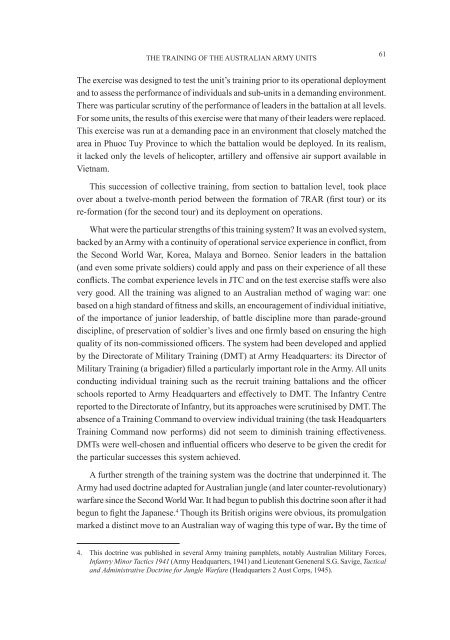conference proceedings - Australian Army
conference proceedings - Australian Army
conference proceedings - Australian Army
You also want an ePaper? Increase the reach of your titles
YUMPU automatically turns print PDFs into web optimized ePapers that Google loves.
The TrAInIng oF The AusTrAlIAn <strong>Army</strong> unITs<br />
The exercise was designed to test the unit’s training prior to its operational deployment<br />
and to assess the performance of individuals and sub-units in a demanding environment.<br />
There was particular scrutiny of the performance of leaders in the battalion at all levels.<br />
For some units, the results of this exercise were that many of their leaders were replaced.<br />
This exercise was run at a demanding pace in an environment that closely matched the<br />
area in Phuoc Tuy Province to which the battalion would be deployed. In its realism,<br />
it lacked only the levels of helicopter, artillery and offensive air support available in<br />
Vietnam.<br />
This succession of collective training, from section to battalion level, took place<br />
over about a twelve-month period between the formation of 7rAr (first tour) or its<br />
re-formation (for the second tour) and its deployment on operations.<br />
What were the particular strengths of this training system? It was an evolved system,<br />
backed by an <strong>Army</strong> with a continuity of operational service experience in conflict, from<br />
the Second World War, Korea, Malaya and Borneo. Senior leaders in the battalion<br />
(and even some private soldiers) could apply and pass on their experience of all these<br />
conflicts. The combat experience levels in JTC and on the test exercise staffs were also<br />
very good. All the training was aligned to an <strong>Australian</strong> method of waging war: one<br />
based on a high standard of fitness and skills, an encouragement of individual initiative,<br />
of the importance of junior leadership, of battle discipline more than parade-ground<br />
discipline, of preservation of soldier’s lives and one firmly based on ensuring the high<br />
quality of its non-commissioned officers. The system had been developed and applied<br />
by the Directorate of Military Training (DMT) at <strong>Army</strong> Headquarters: its Director of<br />
military Training (a brigadier) filled a particularly important role in the <strong>Army</strong>. All units<br />
conducting individual training such as the recruit training battalions and the officer<br />
schools reported to <strong>Army</strong> headquarters and effectively to DmT. The Infantry Centre<br />
reported to the Directorate of Infantry, but its approaches were scrutinised by DMT. The<br />
absence of a Training Command to overview individual training (the task headquarters<br />
Training Command now performs) did not seem to diminish training effectiveness.<br />
DmTs were well-chosen and influential officers who deserve to be given the credit for<br />
the particular successes this system achieved.<br />
A further strength of the training system was the doctrine that underpinned it. The<br />
<strong>Army</strong> had used doctrine adapted for <strong>Australian</strong> jungle (and later counter-revolutionary)<br />
warfare since the Second World War. It had begun to publish this doctrine soon after it had<br />
begun to fight the Japanese. 4 Though its British origins were obvious, its promulgation<br />
marked a distinct move to an <strong>Australian</strong> way of waging this type of war. By the time of<br />
4. This doctrine was published in several <strong>Army</strong> training pamphlets, notably <strong>Australian</strong> military Forces,<br />
Infantry Minor Tactics 1941 (<strong>Army</strong> headquarters, 1941) and lieutenant geneneral s.g. savige, Tactical<br />
and Administrative Doctrine for Jungle Warfare (headquarters 2 Aust Corps, 1945).<br />
61

















